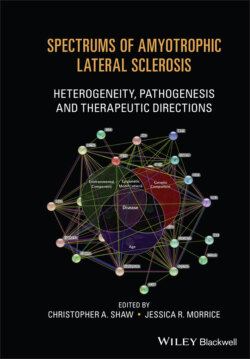Читать книгу Spectrums of Amyotrophic Lateral Sclerosis - Группа авторов - Страница 34
Annexin A11 (ANXA11)
ОглавлениеBy examining families with multiple affected individuals, Smith et al. observed the Annexin A11 (ANXA11) p.D40G variant segregating with ALS [62]. In a replication cohort, additional variants were observed; and while more than half were in the N‐terminus, no functional domain was enriched for variants. These variants may account for as much as 1–2% of ALS, whether sporadic or familial. Variants in ANXA11 in ALS patients were quickly replicated in Chinese cohorts [63–65], with results ranging from ANXA11 variants being a frequently altered gene in sporadic ALS patients [65] to ANXA11 variants being rare and of uncertain impact [64]. As variants will be found at varying frequencies in different cohorts, more studies will be needed to assess whether any given variant is coincidental or an actual cause of disease. Similar to some RNA‐binding proteins and SOD1 [17], ANXA11 variants appear to cause its encoded protein to aggregate when overexpressed, and in turn these ANXA11 aggregates can recruit the wild‐type form of the protein [62]. ANXA11 binds phospholipids in vesicles and may interact with calcyclin in apoptosis and exocytosis pathways [62]. These pathways involve other ALS‐associated genes such as FIG 4, OPTN, and SQSTM1 [66].
FIGURE 2.1 Timeline of ALS gene discovery and the rate of genetically explained cases. (a) Cumulative number of ALS genes discovered. Each circle represents a single gene reported to cause or predispose to ALS, with the size of the circle representing the approximate proportion of cases explained. The smallest size (0%) represents genes with very rare variants or those that are not genetically implicated. (b) Total percent of ALS cases explained by variation in ALS genes over time. The cumulative percent was calculated per year corresponding to gene discovery. Estimated percent is approximate and informed by published reviews [4,54–61].
